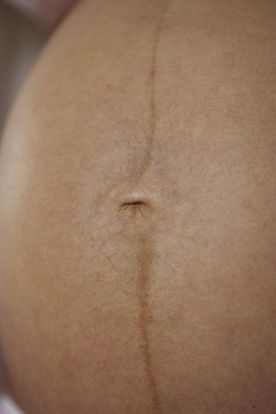14 weeks and 2 days pregnant

In this 3D ultrasound scan, the baby is lying on his back. The arms and legs have lengthened and the baby is able to move them freely. His head is still relatively large compared to the trunk and the forehead bulges out.
He’s well-developed on the outside, but complex changes are taking place as your baby’s internal organs continue to mature.
Your baby’s neck is growing, and he’s now looking more and more like a human being. Internally, the thyroid gland first develops at the base of the tongue but gradually moves down to lie in the neck, overlying the trachea (windpipe). The thyroid gland is producing the hormone thyroxine, using iodine transported from your body across the placenta.
The baby’s kidneys are starting to function. The nephrons in the kidneys are lengthening and maturing: these essential units enable the kidney to function by filtering the blood and eliminating waste from the body.
New nephrons will be produced up until the 37th week and the kidneys continue to lengthen by around 1mm a week during the entire pregnancy.
The majority of employers are supportive when they find out an employee is pregnant, and hopefully this will be the case for you. However, should a problem arise, there is employment law in place to protect pregnant women:
-
You can’t be sacked during pregnancy, unless you breach the terms of your agreement.
-
You can’t be made redundant because you’re pregnant or on maternity leave. However, if the reason for the redundancy is a legitimate one, unconnected with your pregnancy, it is allowed.
-
Your employer has extra responsibilities when you’re pregnant, and these include ensuring that your workplace is safe. For example, you should be protected from handling or lifting heavy loads, standing or sitting for long periods of time, handling toxic substances, or working long hours.
-
You’re entitled to a “reasonable” amount of paid time off for antenatal appointments.
-
Symptoms of pregnancy are considered an illness and can be a valid reason for sick leave.
I’ve developed a dark vertical line down the middle of my tummy. What is this?
This line is called the linea nigra, which occurs due to changes in skin pigmentation. It’s extremely common, affecting 90 per cent of all pregnant women in some way or another, and is often more noticeable if you are darker skinned.
You may also notice a darkening of the skin around your nipples and a darkening of freckles, moles, or birthmarks. A few women may also experience brown patches on their face called chloasma or the “mask of pregnancy”. These changes are caused by the extra amounts of the hormone oestrogen during pregnancy, which affects the melanin-producing cells of the skin – these cells produce the pigment that darkens the skin. These colour changes are normal and will usually fade once the baby is born.

Be the first to support
Be the first to share
Comment (0)
Related Blogs & Vlogs
No related events found.
Loading more...